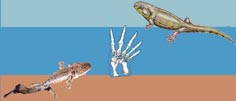Palaeontology: New Devonian lungfishes from East Greenland
Jenny Clack, Tim Smithson, Tom Challands, Ket Smithson
The joint Danish-Cambridge expedition to East Greenland in 1987 collected much new vertebrate material including the now well-known early tetrapod Acanthostega. Among material collected then are three specimens of new, small, lungfishes which are relevant to the TW:eed Project, casting light on lungfish evolution over the Devonian-Carboniferous boundary.
The Late Devonian has been considered the acme of lungfish evolution, with a rich and varied complement of forms representing numerous taxa. Following the Hangenberg Event, marked by a mass extinction at the Devonian-Carboniferous boundary, vertebrate diversity has been considered reduced, recording a post-extinction trough. This is emphasized by the fact that Devonian forms have tended to fall separately from Carboniferous forms in phylogentic analyses, and thus to be generally more ancestral, falling lower down the family tree than Carboniferous forms. An abrupt transition is implied, with no taxonomic overlap between Devonian and Carboniferous taxa.
This paper describes the new specimens from the Devonian of East Greenland, that show some of these advanced characters that are less common in Devonian lungfishes, and compares them with a number of previously known Devonian and Carboniferous specimens held in the Natural History Museum in Copenhagen.
Phylogenetic analysis suggests that the specimens may be closer to Early Carboniferous forms. This reinforces the existence of a cross-over between Devonian and Carboniferous vertebrates. It implies that the post-extinction trough may not have been as severe as previously thought, and some lungfish lineages survived to radiate again early after the extinction event. The supposed post-extinction trough roughly corresponds to a hiatus in the fossil record of tetrapods and other vertebrates following the Hangenberg event and often referred to as 'Romer’s Gap'.
Recent discoveries have suggested that the hiatus may result from a lack of exploration and collecting from earliest Carboniferous continental sequences, and have revealed previously unseen diversity among vertebrate groups including tetrapods, lungfishes and chondrichthyans (sharks and rays).
One interesting aspect of a recently-discovered Canadian lungfish, included in this research for comparison purposes, is trying to work out how the toothplates worked. In this lungfish, of a pair of upper and lower toothplates which occluded, one is flatter, and the other more convex. This implies some sort of rolling motion between them, which in turn suggests a rotational action either in the jaw or skull or both. Such a possibility has never been noticed or discussed previously.
The fact that some Devonian lungfishes show characters more typically seen in Carboniferous forms, and some Carboniferous ones retain characters otherwise seen in Devonian forms implies much more continuity across the Devonian-Carboniferous boundary than previously thought.
Unfortunately the paper is not Open Access, so only subscribers to the journal will have access to it. You can read the abstract on the Palaeontology website.

